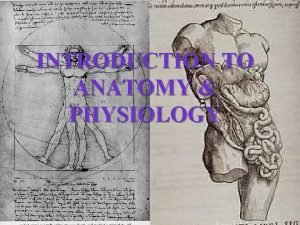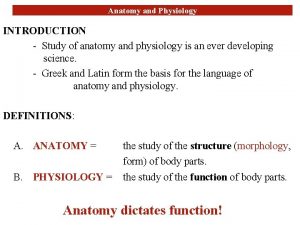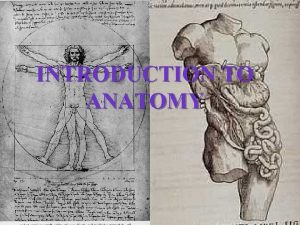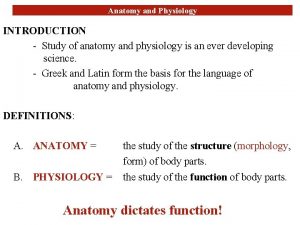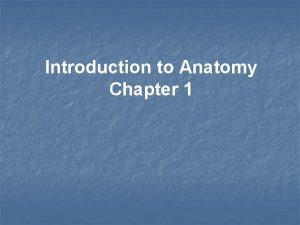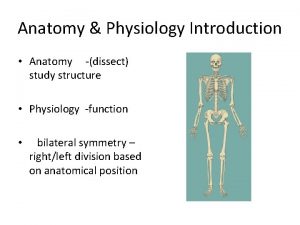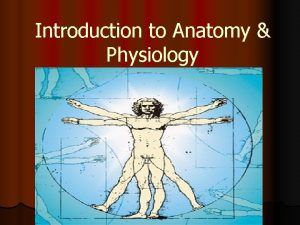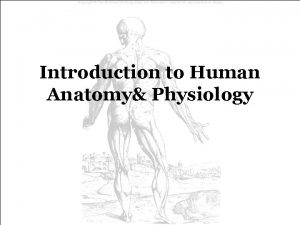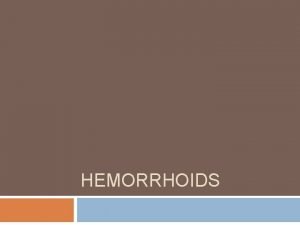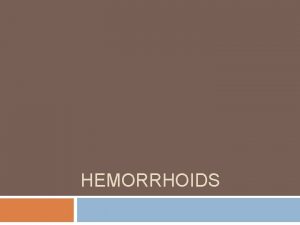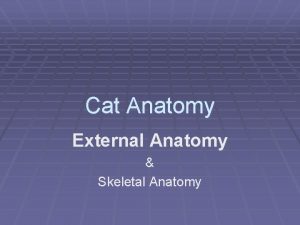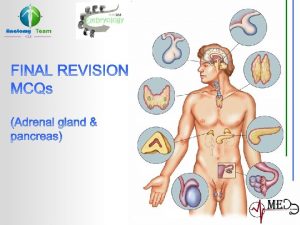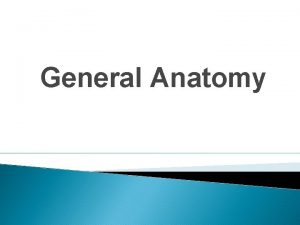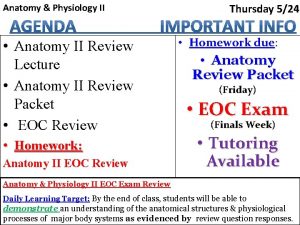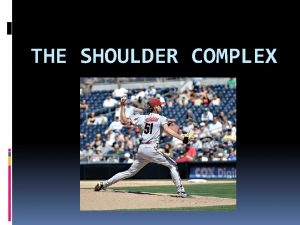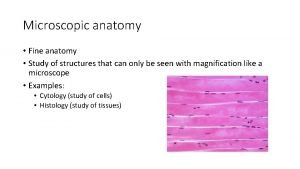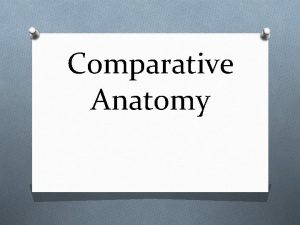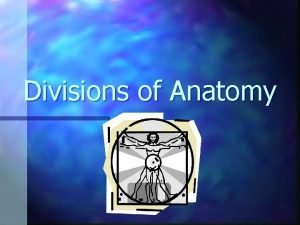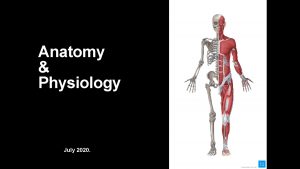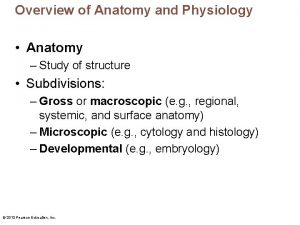Introduction to Anatomy Anatomy is The study of






































- Slides: 38

Introduction to Anatomy

Anatomy is… • The study of structure • We study what it is, what it’s shaped like, what it’s made of • “What is does” is left for physiology next semester

Microscopic vs. Gross Anatomy Microscopic Gross • Structures that cannot be viewed with the naked eye • AKA macroscopic anatomy • anything that can be seen with the naked eye

Approaches to gross anatomy • Comparative anatomy examines similarities and differences of different species

Approaches to gross anatomy • Developmental anatomy investigates the changes in structure from conception through maturity • Embryology is specifically concerned with development before birth

Approaches to gross anatomy • Regional anatomy examines structures in a particular region of the body (e. g. , skin, bones, muscles) • Surface anatomy examines superficial anatomic markings and internal body structures as they relate to the skin covering them • Systemic anatomy studies gross anatomy of each system in the body (ex. digestive, urinary)

Structural organization of the body • Simplest level of organization is chemical level • atoms: the smallest units of matter • molecules: two or more atoms bounded together • Simplest level of LIFE is cellular level

How did we get here? • In the primordial soup, atoms bound together to make molecules • Then fat molecules bound together to make a fat ball with nucleotides inside • Then the nucleotides bound together into a chain and replicated themselves • Let this repeat itself over a billion years, and viola! Life!


Organization • Most basic level of life: cellular level of organization • Most basic organisms are unicellular • Not necessarily old species

red and white blood cells Cellular level of organization • In multicellular organisms, different types of cells have different functions • different functions have different shapes osteocytes make bone muscle cells many types of cells in skin neurons

Tissue level of organization • Cells with a common function are organized into tissues • One tissue may contain several types of cells • In some organisms, tissues not organized into organs red and white blood cells many types of cells in skin

Organ level of organization “brain” • Tissues with similar functions organized into organs teste sperm duct ovary ovariduct seminal vesicles copulatory organ proboscis for feeding gut nerve net

Organ level of organization

Organ system level of development • Organs with similar function work together in systems

Atom Molecule Chemical level Cells Life starts here Cellular level Epithelial tissue Small intestine Tissue level Organ system level Organismal level

What makes life? • A Cell! • Plasma membrane • DNA and other stuff inside

What else makes life? • Organization: complex structure and order • Metabolism: chemical reactions including breaking down molecules into digestible particles • Growth and development: increased size from assimilation of materials from the environment • Responsiveness: sense and respond to changes in the environment • Regulation: maintain a consistent internal environment • Homeostasis is the process of maintaining a steady state inside the body • Reproduction: produce new cells for growth, also replicate self

One more thing • Adaptation • At the population level, organisms adapt (Individuals DON’T adapt) • Each generation is different from the last • Each generation contains individuals whose ancestors were better at reproduction than another individual • Over many generations (thousands to millions of years) populations become altered in response to their environment

Anatomic position • Used when referring to parts of the body • Common point of reference • Standing, facing forward, feet straight head, head forward, arms at sides, palms facing forward, thumbs away from the body

Dividing the body • Planes are imaginary slices that divide the body • Help describe where things are in relation to other things

• Coronal plane Fig. 1. 5 • vertical • divides into front and back • Transverse plane • aka cross-sectional plane or horizontal plane • perpendicular to axis of body • separates into upper and lower (b) Coronal section • Midsaggital plane • vertical through center of body • separates into right and left halves • Saggital plane is to left or right of midsaggital (c) Transverse section (d) Midsagittal section

Dividing the body • Body parts can also be divided along planes Fig. 1. 6

Anatomic directions • Used to describe where things are in relation to other things • Anterior = front • toward the front surface of the body • The coyote’s nose is anterior to its eyes • Ventral = belly side of body • The coyote has a ventral gray patch • ventral = anterior in humans

Anatomic directions • Posterior = back • behind; toward the back surface • The coyote’s cheek lies posterior to its grin • Dorsal = booty side of body • The coyote has a dorsal tail The shark has a scary dorsal fin posterior = dorsal in humans

Anatomic directions • Superior = above • closer to the head • The coyote’s yellow eyes are superior to its tail • Inferior = below • closer to the feet • The coyote’s tail is inferior to its ears

Anatomic directions • Cranial = at the head end • closer to the head • The coyote’s ears are cranial to its shoulders • Caudal = at the tail end • closer to the tail; in humans, closer to the feet • The coyote’s tail is caudal to its ears

Anatomic directions • Medial = middle • toward the midline of the body • The coyote’s chest hair tuft is medial to the arm • Lateral = side • away from the midline of the body • The coyote’s cheeks are lateral to the nose

Anatomic directions • ipsilateral = on the same side • The coyote’s tail is ipsilateral to its raised eyebrow • contralateral = on the opposite side • The right hand is contralateral to the left foot

Anatomic directions • Proximal = closer to the point of attachment to the trunk • The coyote’s knee is proximal to the foot • Distal = farther from the point of attachment to the trunk • The coyote’s fist is distal to the elbow

Anatomic directions • Superficial = on the outside, closer to the outside • The dough boy’s skin is superficial to his intestines • Deep = on the inside, underneath another structure • The dough boy’s heart is deep to his ribs

Medical Imaging • Radiography (X-rays) • X-rays (high-energy radiation) sent through body • Pass through soft tissue, leaving image of hard tissues: bone, teeth, tumors

Medical Imaging • Sonography (ultrasound) • high-frequency sound waves penetrate body, bounce off tissues and return • inexpensive, portable, no harmful radiation • shows hard tissue and some soft tissue • not very sharp images (getting better)

Medical Imaging • Computed Tomography (CT) • • • uses low-intensity X-rays that pass through the body Produces images of dime-thick slices of the body Produces 3 -D image Sharper image that X-rays Visible Human Project

Medical Imaging • Digital Subtraction Angiography (DSA) • 3 -D, X-rays • Used to observe blood vessels • Radiographs taken before and after injecting an opaque medium into blood vessel • Useful in angioplasty (insertion of stent into blocked blood vessel)

Medical Imaging • Dynamic Spatial Reconstruction (DSR) • • Uses modified CT scanners Produces 3 -D images of organs provides info about movement of organ valuable for evaluating heart function

Medical Imaging • Magnetic Resonance Imaging (MRI) • provides image of soft tissues • not clear images of hard tissues • Uses magnet and causes protons in tissues to align • functional MRI (f. MRI) provides map of oxygen flow in the brain

Medical Imaging • Positron emission tomography (PET) • • Analyze metabolic state of tissues Patient injected with radioactive sugar Determine which tissues are most active Can determine if cancer has metastasized
 Hình ảnh bộ gõ cơ thể búng tay
Hình ảnh bộ gõ cơ thể búng tay Frameset trong html5
Frameset trong html5 Bổ thể
Bổ thể Tỉ lệ cơ thể trẻ em
Tỉ lệ cơ thể trẻ em Gấu đi như thế nào
Gấu đi như thế nào Tư thế worm breton là gì
Tư thế worm breton là gì Chúa yêu trần thế
Chúa yêu trần thế Các môn thể thao bắt đầu bằng tiếng nhảy
Các môn thể thao bắt đầu bằng tiếng nhảy Thế nào là hệ số cao nhất
Thế nào là hệ số cao nhất Các châu lục và đại dương trên thế giới
Các châu lục và đại dương trên thế giới Công thức tính độ biến thiên đông lượng
Công thức tính độ biến thiên đông lượng Trời xanh đây là của chúng ta thể thơ
Trời xanh đây là của chúng ta thể thơ Cách giải mật thư tọa độ
Cách giải mật thư tọa độ Làm thế nào để 102-1=99
Làm thế nào để 102-1=99 độ dài liên kết
độ dài liên kết Các châu lục và đại dương trên thế giới
Các châu lục và đại dương trên thế giới Thể thơ truyền thống
Thể thơ truyền thống Quá trình desamine hóa có thể tạo ra
Quá trình desamine hóa có thể tạo ra Một số thể thơ truyền thống
Một số thể thơ truyền thống Cái miệng bé xinh thế chỉ nói điều hay thôi
Cái miệng bé xinh thế chỉ nói điều hay thôi Vẽ hình chiếu vuông góc của vật thể sau
Vẽ hình chiếu vuông góc của vật thể sau Nguyên nhân của sự mỏi cơ sinh 8
Nguyên nhân của sự mỏi cơ sinh 8 đặc điểm cơ thể của người tối cổ
đặc điểm cơ thể của người tối cổ Ví dụ về giọng cùng tên
Ví dụ về giọng cùng tên Vẽ hình chiếu đứng bằng cạnh của vật thể
Vẽ hình chiếu đứng bằng cạnh của vật thể Fecboak
Fecboak Thẻ vin
Thẻ vin đại từ thay thế
đại từ thay thế điện thế nghỉ
điện thế nghỉ Tư thế ngồi viết
Tư thế ngồi viết Diễn thế sinh thái là
Diễn thế sinh thái là Dạng đột biến một nhiễm là
Dạng đột biến một nhiễm là Số nguyên tố là gì
Số nguyên tố là gì Tư thế ngồi viết
Tư thế ngồi viết Lời thề hippocrates
Lời thề hippocrates Thiếu nhi thế giới liên hoan
Thiếu nhi thế giới liên hoan ưu thế lai là gì
ưu thế lai là gì Sự nuôi và dạy con của hươu
Sự nuôi và dạy con của hươu Khi nào hổ mẹ dạy hổ con săn mồi
Khi nào hổ mẹ dạy hổ con săn mồi









































